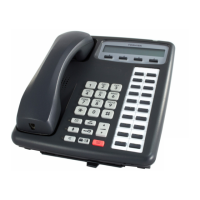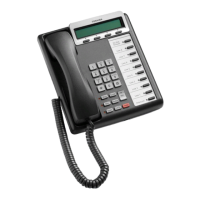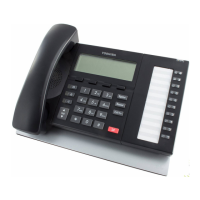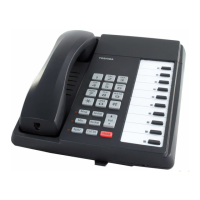RBSU/RBSS ISDN Basic Rate Interface Unit
DK40 Universal Slot PCBs
Strata DK40 I&M Manual Spring 1999
3-59
Refer to the Strata DK40 Programming Manual or DK Library CD-Rom for more details.
conference board) that is designed to plug directly into the ISDN (S/T) interface without the
use of a TA.
The RBSU/RBSS BRI-NT interface supports a point-to-multipoint connection on two
twisted pairs. Up to eight TE and/or TA devices can be connected to one RBSU/RBSS,
BRI-NT circuit. Using standardized wiring and modular connectors, as explained in
previous paragraphs, maintains control of polarity. The pinout from the RBSU/RBSS circuit
to a S-type TE or TA device is shown in Figure 3-32 and Table 3-16.
Figure 3-32 RBSU/RBSS NT Circuit Pinout on Passive Bus
As a parallel bus, the RBSU/RBSS BRI-NT passive bus will accept TE and TA devices
scattered on the bus; however, the locations of the TE and TA devices on the S bus is limited
by timing considerations. All connections should be installed in accordance with BS EN
50098-1: 1994 (or the latest issue).
To control electrical characteristics, a 100-ohm terminating resistor (TR) is required at both
ends of the passive bus. One resistor should be across the Tx pair and one across the Rx pair
at either end of the passive bus.
The RBSU and RBSS circuits provide an option switch that allows the 100-ohm TR to be
switched into the circuit on the DK side of the bus (See Table 3-14 on Page 3-50). Most TE
and TA devices also provide option switches to connect 100-ohm terminating resistors as
shown in Figure 3-31.
If the TE or TA devices do not provide TRs, they may be permanently wired in place on a RJ-
45 jack at the far end of the bus. Only one terminating resistor on each pair should be on the
far (TE) end of the passive bus - do not switch in TRs on more than one TE or TA device on
the passive bus.
Note
The correct placement of TRs on the passive bus is critical to ISDN BRI circuit
operation (See “RBSU/RBSS Passive Bus Configurations” on Page 3-60).
RBSU
TE-Circuit
Insert 100-ohm
TR using RBSU
and RBSS
option switches.
RJ-45
Pinout
3041
S-type, TEs or TAs without
100-ohm terminating resistors
(maximum eight TEs or TAs per
RBSU/RBSS circuit).
BRI (Four-wire)
3
6
4
5
3
6
4
5
RJ-45
Pinout
S-type, TE or TA with
100-ohm TR or just a
100-ohm terminating
resistor across each pair
on a RJ-45 jack.
To local
AC Power
To local
AC Power
3 6 4 5

